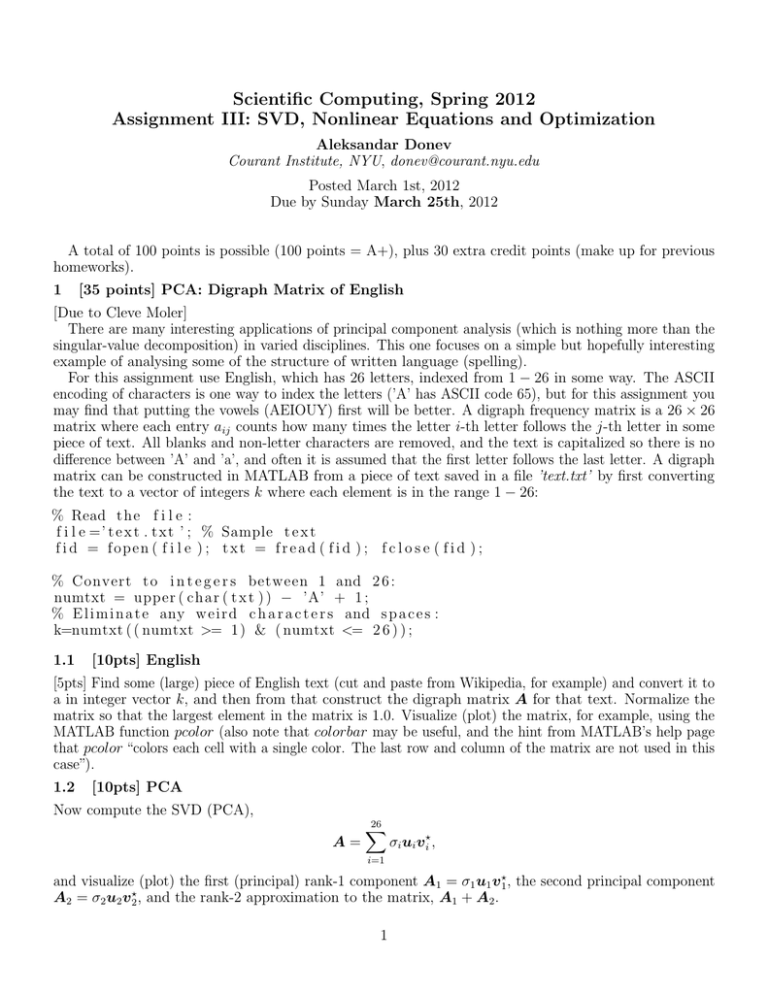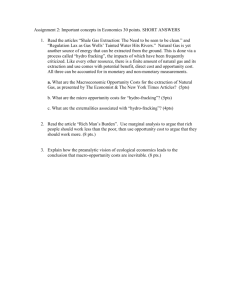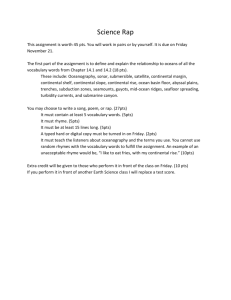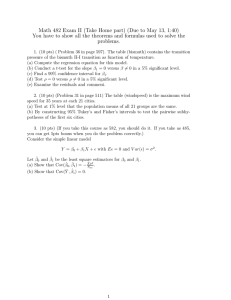Scientific Computing, Spring 2012 Assignment III: SVD, Nonlinear Equations and Optimization
advertisement

Scientific Computing, Spring 2012 Assignment III: SVD, Nonlinear Equations and Optimization Aleksandar Donev Courant Institute, NYU, donev@courant.nyu.edu Posted March 1st, 2012 Due by Sunday March 25th, 2012 A total of 100 points is possible (100 points = A+), plus 30 extra credit points (make up for previous homeworks). 1 [35 points] PCA: Digraph Matrix of English [Due to Cleve Moler] There are many interesting applications of principal component analysis (which is nothing more than the singular-value decomposition) in varied disciplines. This one focuses on a simple but hopefully interesting example of analysing some of the structure of written language (spelling). For this assignment use English, which has 26 letters, indexed from 1 − 26 in some way. The ASCII encoding of characters is one way to index the letters (’A’ has ASCII code 65), but for this assignment you may find that putting the vowels (AEIOUY) first will be better. A digraph frequency matrix is a 26 × 26 matrix where each entry aij counts how many times the letter i-th letter follows the j-th letter in some piece of text. All blanks and non-letter characters are removed, and the text is capitalized so there is no difference between ’A’ and ’a’, and often it is assumed that the first letter follows the last letter. A digraph matrix can be constructed in MATLAB from a piece of text saved in a file ’text.txt’ by first converting the text to a vector of integers k where each element is in the range 1 − 26: % Read t h e f i l e : f i l e =’ t e x t . txt ’ ; % Sample t e x t f i d = fopen ( f i l e ) ; txt = fread ( f i d ) ; f c l o s e ( f i d ) ; % Convert t o i n t e g e r s between 1 and 2 6 : numtxt = upper ( char ( t x t ) ) − ’A’ + 1 ; % E l i m i n a t e any weird c h a r a c t e r s and s p a c e s : k=numtxt ( ( numtxt >= 1 ) & ( numtxt <= 2 6 ) ) ; 1.1 [10pts] English [5pts] Find some (large) piece of English text (cut and paste from Wikipedia, for example) and convert it to a in integer vector k, and then from that construct the digraph matrix A for that text. Normalize the matrix so that the largest element in the matrix is 1.0. Visualize (plot) the matrix, for example, using the MATLAB function pcolor (also note that colorbar may be useful, and the hint from MATLAB’s help page that pcolor “colors each cell with a single color. The last row and column of the matrix are not used in this case”). 1.2 [10pts] PCA Now compute the SVD (PCA), A= 26 X σi ui v ?i , i=1 and visualize (plot) the first (principal) rank-1 component A1 = σ1 u1 v ?1 , the second principal component A2 = σ2 u2 v ?2 , and the rank-2 approximation to the matrix, A1 + A2 . 1 1.3 [10pts] What can we learn from the PCA? [5pts] Can you see some features of the English language that the first principal component captures? [Hint: Doing sum(A) computes the frequency of occurence of the different letters (make sure you understand why!)] [5pts] Can you see some features of the English language that the second principal component captures? Hint: The following permutation will reorder the letters so that the vowels come first: p=[1 ,5 ,9 ,15 ,21 ,25 ,2:4 ,6:8 ,10:14 ,16:20 ,22:24 ,26]; c h a r ( p+’A’ −1) % The re−o r d e r e d ’ alphabet ’ 1.4 [5pts] Problems [2.5pts] Are there any obvious features of the English language that the rank-2 approximation misses or gets wrong? [2.5 pts] Do some testing to make sure that what you are observing is a feature of the language and not the particular text you chose. For example, try a different longer text. How long does the text need to be to see the features clearly? 2 [35 points] Newton-Raphson Method in One Dimension Consider finding the three roots of the polynomial f (x) = 816x3 − 3835x2 + 6000x − 3125, which happen to all be real and all contained in the interval [1.4, 1.7] [due to Cleve Moler]. 2.1 [5pts] The roots Plot this function on the interval [1.4, 1.7] and find all of the zeros of this polynomial using the MATLAB function f zero [Hint: The roots values can be obtained in MATLAB using the built-in function roots but Maple tells us the roots are 25/16, 25/17 and 5/3]. 2.2 [15 pts] Newton’s Method [7.5pts] Implement Newton’s method (no safeguards necessary) and test it with some initial guess in the interval [1.4, 1.7]. [7.5pts] Verify that the order of convergence is quadratic, as predicted by the theory from class: k+1 00 e f (α) . → 0 2f (α) |ek |2 [Hint: Due to roundoff errors and the very fast convergence, the error quickly becomes comparable to roundoff, so one must be careful not to use very large k] 2.3 [15pts] Robustness [7.5pts] Starting from many (say 100) guesses in the interval [1.4, 1.7], run 100 iterations of Newton’s method and see plot the value to which it converges, if it does, as a function of the initial guess. If the initial guess is sufficiently close to one of the roots α, i.e., if it is within the basin of attraction for root α, it should converge to α. What is the basin of attraction for the middle root (α = 25/16) based on the plot? [5pts] The theory from the lecture suggested an estimate for the width of each basin of attraction around a given root α of the form: −1 0 00 x − α ≤ f (α) . 2f 0 (α) Compare these estimates to what is actually observed numerically. [2.5pts] Is the estimate particularly bad for one of the roots, and if so, can you think of reasons why? 2 3 [30 pts + 30 extra credit] Nonlinear Least-Squares Fitting In homework 2 you considered fitting a data series (xi , yi ), i = 1, . . . , m, with a function that that depends linearly on a set of unknown fitting parameters c ∈ Rn . Consider now fitting data to a nonlinear function of the fitting parameters, y = f (x; c). The least-squares fit is the one that minimizes the squared sums of errors, c? = arg min c m X [f (xi ; c) − yi ]2 = arg min (f − y)T (f − y) , c i=1 (1) where f (c) = f (x; c) is a vector of m function values, evaluated at the data points, for a given set of the parameters c. We will consider here fitting an exponentially-damped sinusoidal curve with four unknown parameters (amplitude, decay, period, and phase, respectively), f (x; c) = c1 e−c2 x sin (c3 x + c4 ) , (2) to a synthetic data set. 3.1 [5pts] Synthetic Data Generate synthetic data by generating m = 100 points randomly and uniformly distributed in the interval 0 ≤ x ≤ 10 by using the rand function. Compute the actual function f (x; c) = e−x/2 sin (2x) , (3) and then add perturbations with absolute value on the order of 10−2 to the y values (use the rand or the randn function). Compare the synthetic data to the actual function on the same plot to see how closely the data set follows the relation (3). 3.2 [25 pts] Gauss-Newton Method The basic idea behind the Gauss-Newton method is to make a linearization of the function f (xi ; c) around the current estimate ck , f (c) ≈ f (ck ) + [J (ck )] (c − ck ) = f (ck ) + [J (ck )] ∆ck , where the Jacobian m × n matrix is the matrix of partial derivatives ∂f /∂c evaluated at the data points: J (c) = ∇c f (c). This approximation (linearization) transforms the non-linear problem (1) into a linear least-squares problem, i.e., an overdetermined linear system [J (ck )] ∆ck = J k ∆ck = y − f (ck ), (4) which you know how to solve from previous homeworks and lectures. The standard approach is to use the normal equations, which does not lead to substantial loss of accuracy if one assumes that the original problem is well-conditioned. Gauss-Newton’s algorithm is a simple iterative algorithm of the form ck+1 = ck + ∆ck , starting from some initial guess c0 . The iteration is terminated, for example, when the increment k∆ck k becomes too small. [15 pts] Implement Gauss-Newton’s algorithm and see whether it works for the problem at hand, using an initial guess c0 that is close to the correct values. [5pts] If you start with c0 = (1, 1, 1, 1), does the method converge to the correct answer? Play around a bit with initial guesses and see if the method converges most of the time, and whether it converges to the “correct” solution or other solutions. [5pts] Is this method the same or even similar to using Newton’s method (for optimization) to solve the non-linear problem (1). 3 3.3 [30pts Extra Credit] Levenberg-Marquardt Algorithm The Gauss-Newton algorithm is not very robust. It is not guaranteed to have even local convergence. A method with much improved robustness can be obtained by using a modified (regularized) version of the normal equations for the overdetermined system (4), T J k J k + λk Diag J Tk J k ∆ck = J Tk (y − f ) , (5) where λk > 0 is a damping parameter that is used to ensure that ∆ck is a descent direction, in the spirit of quasi-Newton algorithms for optimization. Here Diag(A) denotes a diagonal matrix whose diagonal is the same as the diagonal of A. If λk is large, the method will converge slowly but surely, while a small λk makes the method close to the Gauss-Newton Method, which converges rapidly if it converges at all. So the idea is to use a larger λk when far from the solution, and then decrease λk as approaching the solution. The actual procedure used to adjust the damping parameter is somewhat of an art, and here we study one simple but effective strategy. [20 pts] Implement a code that repeats the following cycle for k = 1, 2, . . . until the increment k∆ck k becomes too small, starting with an initial value λ = 1 and some guess c0 : 1. Evaluate the function for the present estimate of the parameters, f k = f (x; ck ), and then compute the residual rk = (f k − y)T (f k − y) . Recall that the goal is to minimize the residual. 2. Using λk = λ, compute a new trial point ck+1 by solving the system (5), evaluate the new f k+1 = f (x; ck+1 ), and then compute the new residual rk+1 . 3. Repeat step 2 for λk = λ/2 and compute the resulting residual r̃k+1 . We now have three residuals, the previous value rk , and the two new trial values rk+1 and r̃k+1 . 4. If r̃k+1 is the smallest of the three residuals, then accept the trial value ck+1 obtained for λk = λ/2, decrease λ ← λ/2, and repeat the cycle again. 5. If rk+1 is the smallest of the three residuals, then accept the trial value ck+1 obtained for λk = λ, and repeat the cycle again. 6. If rk is the smallest of the three residuals, then increase λ ← 2λ and compute the resulting residual. Keep doubling λ until the residual is smaller than rk . Accept the new value of ck+1 and repeat the cycle. [Hint: The MATLAB call diag(diag(A)) can be used to obtain DiagA, as used in (5).] Test that the algorithm converges using an initial guess c0 that is close to the correct values. [2.5 pts] If you start with c0 = (1, 1, 1, 1), does the improved method converge to the correct answer? [2.5 pts] Can you find some initial guess c0 for which even the improved method does not converge to the correct values? Does it converge to another local minimum or not converge at all? [5 pts] If the synthetic data points have no error (i.e., yi = f (xi ; c) to within roundoff error), how many digits of accuracy in c can you obtain, starting with c0 = (1, 1, 1, 1)? How many steps do you need to achieve this accuracy. 4



